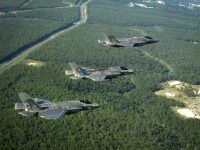The State Department has made a determination approving a possible Foreign Military Sale to the Government of Germany of F-35 Aircraft, Munitions, and related equipment for an estimated cost of $8.4 billion. The Government of Germany has requested to buy thirty-five (35) F-35 Joint Strike Fighter Conventional Take Off and Landing (CTOL) aircraft; thirty-seven (37) Pratt & Whitney F135-PW-100 engines (35 installed, 2 spares); one hundred five (105) AIM-120C-8 Advanced Medium Range Air-to-Air Missiles (AMRAAM); four (4) AIM-120C-8 AMRAAM Guidance Sections; seventy-five (75) AGM-158B/B2 Joint Air-to-Surface Standoff Missiles-Extended Range (JASSM-ER); two (2) AGM-158 Inert JASSMs with Test Instrumentation Kits (TIK); two (2) AGM-158 JASSM Separation Test Vehicles (STV); three hundred fortyfour (344) GBU-53 Small Diameter Bombs (SDB-II); three (3) GBU-53 SDB-II Guided Test Vehicles (GTV); eight (8) GBU-53 SDB-II Captive Carry Reliability Trainers (CCRT); one hundred sixty-two (162) BLU-109 2000LB Hardened Penetrator Bombs for GBU-31; two hundred sixty four (264) MK-82 500LB General Purpose (GP) Bombs for GBU-54; six (6) MK-82 Inert Filled GP Bombs; thirty (30) BLU-109 Inert 2000LB Hardened Penetrator Bombs; one hundred eighty (180) KMU-557 Joint Direct-Attack Munition (JDAM) Tail Kits for GBU-31; two hundred forty-six (246) KMU-572 JDAM Tail Kits for GBU-54; seventy-five (75) AIM-9X Block II+ Tactical Sidewinder Missiles; thirty (30) AIM-9X Block II Sidewinder Captive Air Training Missiles (CATM); fifteen (15) Tactical AIM-9X Block II+ Sidewinder Guidance Control Units; and five (5) AIM-9X Block II Sidewinder CATM Guidance Units.
Also included are AIM-120 control sections, propulsion sections, telemetry systems, warheads, and containers; AIM-120 CATMs; AIM-9 Active Optical Target Detectors and containers; FMU-139 joint programmable fuzes; DSU-38 Laser-Illuminated Target Detectors for GBU-54; AN/PYQ-10 Simple Key Loaders; Common Munitions Built-in-Test Reprogramming Equipment (CMBRE) and ADU-891/E Adapter Group Computer Test Sets; KGV-135A embedded secure communications devices; Cartridge Actuated Devices/Propellant Actuated Devices (CAD/PAD); impulse cartridges, chaff, and flares; Full Mission Simulators and system trainers; training missiles and components; electronic warfare systems and Reprogramming Lab support; logistics management and support systems; threat detection, tracking, and targeting systems; Contractor Logistics Support (CLS); classified software and software development, delivery and integration support; transportation, ferry, and refueling support; weapons containers; aircraft and munitions support and support equipment; integration and test support and equipment; aircraft engine component improvement program (CIP) support; secure communications, precision navigation, and cryptographic systems and equipment; Identification Friend or Foe (IFF) equipment; spare and repair parts, consumables, accessories, repair support; minor modifications, maintenance, and maintenance support.

On 27 February 2022 the German Chancellor Olaf Scholz announced a €100 billion fund for the Bundeswehr in response to the full-scale invasion of Ukraine by Russia. In March 2022, the German defense ministry announced its intention to use the fund to buy 35 F-35s to partially replace the Bundeswehr’s Panavia Tornado aircraft before 2030. Germany has long resisted pressure from the United States and others to raise its defence spending to 2% of economic output in the light of its 20th century history and resulting strong pacifism among its population. According to NATO statistics, Germany is expected to have spent 1.53% of its GDP on defence in 2021. the government had decided to supply 100 billion euros for military investments from its 2022 budget. Germany’s entire defence budget by comparison was 47 billion euros in 2021. Germany could purchase U.S. F-35 fighter jets built by Lockheed Martin to replace its ageing Tornado in the role of nuclear sharing. That F-35 certification to carry nuclear weapons is already in progress was a crucial factor in favoring the F-35 over the also discussed F/A-18E/F and potential Eurofighter, as the acquired aircraft would be part of NATO’s nuclear sharing concept. But the next generation of fighter jets and tanks must be built in Europe jointly with European partners, particularly with France.
The Lockheed Martin F-35 Lightning II is an American family of single-seat, single-engine, all-weather stealth multirole combat aircraft that is intended to perform both air superiority and strike missions. It is also able to provide electronic warfare and intelligence, surveillance, and reconnaissance capabilities. Lockheed Martin is the prime F-35 contractor, with principal partners Northrop Grumman and BAE Systems. The aircraft has three main variants: the conventional takeoff and landing (CTOL) F-35A, the short take-off and vertical-landing (STOVL) F-35B, and the carrier-based (CV/CATOBAR) F-35C. The aircraft descends from the Lockheed Martin X-35, which in 2001 beat the Boeing X-32 to win the Joint Strike Fighter (JSF) program. Its development is principally funded by the United States, with additional funding from program partner countries from NATO and close U.S. allies, including the United Kingdom, Australia, Canada, Italy, Norway, Denmark, the Netherlands, and formerly Turkey. Several other countries have ordered, or are considering ordering, the aircraft. The F-35 first flew in 2006 and entered service with the U.S. Marine Corps F-35B in July 2015, followed by the U.S. Air Force F-35A in August 2016 and the U.S. Navy F-35C in February 2019. The aircraft was first used in combat in 2018 by the Israeli Air Force. The U.S. plans to buy 2,456 F-35s through 2044, which will represent the bulk of the crewed tactical aviation of the U.S. Air Force, Navy, and Marine Corps for several decades; the aircraft will be a cornerstone of NATO and U.S.-allied air power and is expected to operate until 2070.
